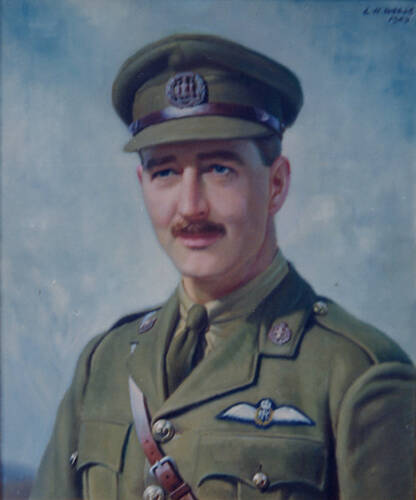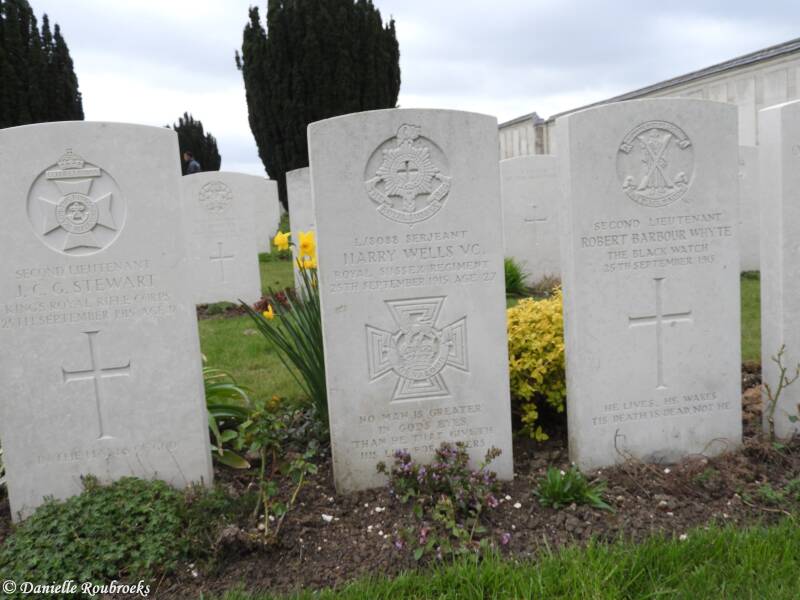Dud Corner Cemetery
Historical Information (Source: CWGC)
The name "Dud Corner" is believed to be due to the large number of unexploded enemy shells found in the neighbourhood after the Armistice. The only burials here during hostilities were those of four Officers of the 9th Black Watch and one Private of the 8th Royal Dublin Fusiliers, close to Plot III, Row B; the remainder of the graves were brought in later from isolated positions near Loos and to the North, and from certain small cemeteries.
There are now nearly 2,000, 1914-18 war casualties commemorated in this site. Of these, over half are unidentified and special headstones have been erected to 15 soldiers from the United Kingdom who are believed to be buried among them. The great majority of the dead buried here fell in the Battle of Loos 1915; but some were killed in succeeding years. Originally, the regimental memorials for the following units were brought into the cemetery:- 10th Scottish Rifles and the 17th London Regiment, dating from the Battle of Loos, and those of the Royal Montreal Regiment and the Royal Highlanders of Canada, dating from the Battle of Hill 70 in August 1917. These memorials were later removed. Special memorials are erected in this Cemetery to twelve soldiers of the 2nd Welch Regiment, killed in action on the 12th October 1915, and originally buried in Crucifix Cemetery, Loos, whose graves could not be found on concentration. The cemetery now covers an area of 5,550 square metres, and is bounded by a low rubble wall except on the road side, where the War Stone is raised on a grass terrace and flanked by buildings.
VICTORIA CROSS
Captain Anketell Moutray READ - 1st Bn. Northamptonshire Regiment, formerly Royal Flying Corps
Died 25 September 1915
Country of Service: United Kingdom
Awards: Victoria Cross
Citation
An extract from the "London Gazette," dated 16th Oct., 1917, records the following:-"For most conspicuous bravery and determination. He was one of a post commanded by Lce. Serjt. Moyney, which was surrounded. The post held out for 96 hours, but after that time was attacked from all sides in overwhelming numbers and was forced to retire. Pte. Woodcock covered the retirement with a Lewis gun, and only retired when the enemy had moved round and up to his post and were only a few yards away. He then crossed the river, but hearing cries for help behind him, returned and waded into the stream amid a shower of bombs from the enemy and rescued another member of the party. The latter he then carried across the open ground in broad daylight towards our front line regardless of machine gun fire that was opened on him."
Grave Reference: IV. F. 3.
(Source: Wikipedia)
Serjeant Harry WELLS - L/8088 - 2nd Bn. Royal Sussex Regiment
Died 25 September 1915
Country of Service: United Kingdom
Awards: Victoria Cross
Citation
An extract from the "London Gazette," No. 29371, dated 16th Nov., 1915, records the following:- "When his Platoon Officer had been killed he took command and led his men forward to within fifteen yards of the German wire. Nearly half the Platoon were killed or wounded, and the remainder were much shaken, but with the utmost coolness and bravery, Serjeant Wells rallied them and led them forward. Finally, when very few were left, he stood up and urged them forward once more, but while doing this he was killed. He gave a magnificent example of courage and determination."
Grave Reference: V. E. 2.
(Source: Wikipedia)




































